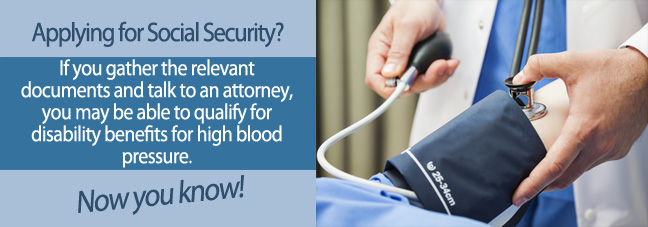High blood pressure, or hypertension, is incredibly common in the medical community. However, in some cases, high blood pressure can be chronic and dangerously severe, resulting in symptoms that can prevent a person from living their normal life.
If your high blood pressure leaves you unable to work or complete daily tasks, then you may want to consider applying for Social Security disability benefits. Before you do, look below to learn the three best tips for applying with high blood pressure.
Tip #1: Receive updated MRIs, CT scans, stress tests, blood tests, and blood pressure measurements.
High blood pressure can occasionally be tricky to qualify with because it is a common diagnosis. When applying, your goal should be to show the Social Security Administration (SSA) that your high blood pressure is more severe than the average case.
One of the best ways to do this is by providing up-to-date tests. MRIs and CT scans can show any areas of the body with damage due to blood pressure, such as the brain, eyes, or limbs.
Blood tests can show abnormalities or other disorders linked to your hypertension. And, of course, blood pressure measurements can measure the overall severity of your high blood pressure.
Tip #2: List all previous medications, diet changes, and therapy strategies you’ve explored, especially those that haven’t worked.
There are many different treatment options available to people with hypertension. Before the SSA will approve a case, they want to be certain that the applicant has tried as many options as possible before requiring government assistance.
Medication lists are a great place to start, especially if certain medications (which range in effectiveness from person to person) haven’t worked for you. Lifestyle changes are also a common prescription, so documented dietary changes or weight loss should also be listed.
Alternatives like physical therapy, massage therapy, or chiropractic therapy may also show the SSA your inability to find a beneficial or stable treatment option.

Tip #3: Document all the ways your high blood pressure limits you in your daily life and at your workplace.
Aside from medical terminology, the SSA needs to know all the ways your high blood pressure affects your life. No official medical knowledge is necessary here — you need only to list your daily activities and the ways your high blood pressure limits you.
For example, if your condition leaves you with vision problems and shortness of breath, it may be difficult for you to go to the store or even cook for yourself on a daily basis.
Headaches or nausea may also make it difficult for you to even complete sedentary work, get from place to place, or take care of other family members. The more ways your high blood pressure limits you, the more likely you are to qualify for benefits.
Contacting an Attorney
Disability applications can be intimidating, especially when small details can make or break your case. To give yourself the best chance at qualifying, consider contacting a disability attorney today and seeing how the lawyer can help you.
Not only can they keep paperwork and information in order, but they can continuously update the SSA after your application is complete. Even better, they are federally required to only take payment if you win your case.
Before applying, consider a free consultation with a disability attorney today.